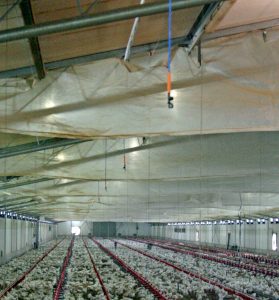Trialling a short burst in-shed sprinkler system
Litter management remains a high priority for the chicken meat industry, mainly because of the adverse effects that ‘wet litter’ can have on bird health, welfare and the environment. Recent research supported by the Poultry CRC has shown that high relative humidity in meat chicken sheds is one of the many things that can contribute to wet litter and makes managing litter conditions more challenging. High in-shed relative humidity can be caused by weather, low ventilation rates but also by the use of evaporative cooling. Evaporative cooling equipment is installed, by necessity, in virtually all mechanically ventilated meat chicken sheds because it is effective at reducing air temperature, but it also increases the relative humidity.
High in-shed relative humidity can increase the wetness of litter due to condensation or water absorption and also reduces water evaporation from the litter. These increase the dampness of the litter surface, leading to reduced friability and increasing the tendency for the surface to become caked with manure. High in-shed relative humidity also increases the ‘feels like’ temperature for the birds. Overall, reducing in-shed relative humidity may provide some tangible benefits.
Researchers at the Department of Agriculture and Fisheries, Queensland, are trialling an in-shed sprinkler system in tunnel ventilated meat chicken sheds as one way to reduce in-shed relative humidity by delaying the use of evaporative cooling pads. The project, led by Mark Dunlop, is funded by the Rural Industries Research and Development Corporation (RIRDC) Chicken Meat Program. The sprinkler system uses a series of low pressure sprinkler nozzles, suspended from the ceiling, to spray water evenly throughout the shed onto the birds. A precision controller uses a clock, timers and in-shed temperature sensors to automatically apply a precise amount of water when it is required.

As Mark explains, “water is sprayed on the birds to create an evaporative cooling effect directly on the birds rather than cooling and humidifying all the air entering the shed. This requires less water than evaporative cooling and also encourages the birds to stand up and move about, which releases heat from their body and the litter surface.” Those who have been in the industry for a while may recall that sprinklers have previously been used in meat chicken sheds. The big difference is that the current system applies water for 10-20 seconds every 7 to 60 minutes depending on how much cooling is required. Mark explains that “the short bursts of water application do not increase the in-shed relative humidity, and the breaks between water applications allow the water that is applied (20-40L over the entire shed floor) to evaporate before more is added.”
The sprinkler system being trialled has been developed by a Canadian company, but the concept has also been the subject of extended University trials in the United States of America. Mark says “our trial is focussing on potential water savings, litter conditions, temperature, relative humidity and how the birds respond to direct water spraying. We’re also observing how suitable the system is in Australian sheds given differences in design, climate and production practices.” Mark concluded by saying that “the system may not be of interest to all growers, but this low cost system may prove to be ideal for growers who are looking for an additional or complementary cooling system, or need to save on water used for evaporative cooling”. Results from the trial are expected in mid-2018.
Please note, this story is: ©2016 The State of Queensland.

